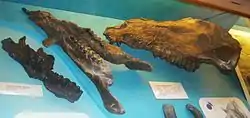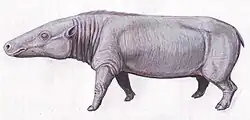| Anthracotherium | |
|---|---|
 | |
| Anthracotherium magnum skull and jaws | |
| Scientific classification | |
| Domain: | Eukaryota |
| Kingdom: | Animalia |
| Phylum: | Chordata |
| Class: | Mammalia |
| Order: | Artiodactyla |
| Family: | †Anthracotheriidae |
| Subfamily: | †Anthracotheriinae |
| Genus: | †Anthracotherium G. Cuvier, 1822 |
| Species | |
Anthracotherium (from Greek: ἄνθραξ anthrax, 'coal' and Greek: θηρίον therium 'beast')[3] is an extinct genus of artiodactyls characterized by having 44 teeth, with five semi-crescentic cusps on the crowns of the upper molars. The genus ranged from the middle Eocene period until the early Miocene, having a distribution throughout Eurasia.[4] Material subjectively assigned to Anthracotherium from Pakistan suggests the last species died out soon after the start of the Miocene.[1]
Description
The genus typifies the family Anthracotheriidae, if only because it is the most thoroughly studied. In many respects, especially the anatomy of the lower jaw, Anthracotherium, as with the other members of the family, is allied to the hippopotamus, of which it is probably an ancestral form.[4] Anthracotheres, together with hippos, are grouped with cetaceans in the clade Whippomorpha.
Etymology
The genus name stems from the fact that the holotype and other first specimens were originally obtained from the Paleogene (previously known as "Tertiary")-aged lignite-beds of Europe.[4]
The European Anthracotherium magnum was approximately as large as a pygmy hippo (about 2 m long and weighing up to 250 kg), but there were several smaller species and the genus also occurs in Egypt, India and North America.[4][5] Members of the genus Anthracotherium, as well as other members of the family Anthracotheriidae, are known colloquially as anthracotheres.
 Anthracotherium magnum
Anthracotherium magnum Anthracotherium sp. coprolite at the Museum für Naturkunde, Berlin
Anthracotherium sp. coprolite at the Museum für Naturkunde, Berlin
References
- 1 2 SAN, NWE NWE, and THAUNG HTIKE. "New discovery of anthracotheres (Mammalia, Artiodactyla) from the Middle Miocene of Sagaing Region, Upper Myanmar." (2014).
- ↑ Scherler, Laureline; Lihoreau, Fabrice; Becker, Damien (8 September 2018). "To split or not to split Anthracotherium? A phylogeny of Anthracotheriinae (Cetartiodactyla: Hippopotamoidea) and its palaeobiogeographical implications". Zoological Journal of the Linnean Society. 185 (2): 487–510. doi:10.1093/zoolinnean/zly052. Retrieved 17 March 2023.
- ↑ Roberts, George (1839). An etymological and explanatory dictionary of the terms and language of geology. London: Longman, Orme, Brown, Green, & Longmans. p. 9. Retrieved 29 December 2021.
- 1 2 3 4 One or more of the preceding sentences incorporates text from a publication now in the public domain: Chisholm, Hugh, ed. (1911). "Anthracotherium". Encyclopædia Britannica. Vol. 2 (11th ed.). Cambridge University Press. p. 106.
- ↑ L'ANTHRACOTHERIUM (in italian)